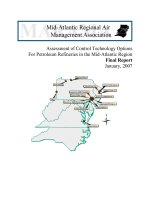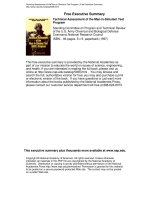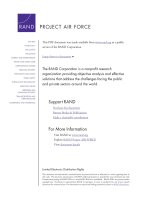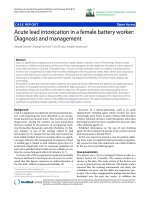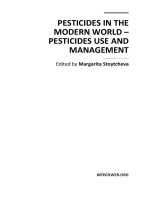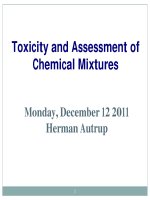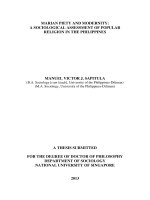Assessment of iron toxicity in lateritic wetland soils of kerala and management using non conventional sources of lime
Bạn đang xem bản rút gọn của tài liệu. Xem và tải ngay bản đầy đủ của tài liệu tại đây (390.35 KB, 10 trang )
Int.J.Curr.Microbiol.App.Sci (2020) 9(5): 2139-2148
International Journal of Current Microbiology and Applied Sciences
ISSN: 2319-7706 Volume 9 Number 5 (2020)
Journal homepage:
Original Research Article
/>
Assessment of Iron Toxicity in Lateritic Wetland Soils of Kerala and
Management using Non Conventional Sources of Lime
Biju Joseph1*, R. Gladis1, B. Aparna1 and J.S. Bindhu2
1
Department of Soil Science & Agricultural Chemistry, 2Department of Agronomy,
College of Agriculture, Vellayani - 695522, Kerala Agricultural University, India
*Corresponding author
ABSTRACT
Keywords
Iron toxicity, Soil
acidity,
Phosphogypsum,
Lime stone powder,
Rice
Article Info
Accepted:
15 April 2020
Available Online:
10 May 2020
Iron toxicity and acidity are the major constraints in the laterite derived paddy soils of
Kerala. More than 90 % of the midland lateritic rice soils in the northern part of Kerala are
strongly acidic in reaction with pH values in the range of 4.5 to 5.5. The content of 0.1 N
HCl extractable Fe in soil varied from 52.21 – 414.9 mg kg-1 and more than 50 % of the
rice soils showed iron toxicity problem (> 250 mg kg -1 of available iron). A field
experiment conducted to evaluate the effectiveness of non conventional liming materials
like phosphogypsum, limestone powder and their blends in managing iron toxicity and soil
acidity for enhancing the yield of rice in comparison to conventional shell lime revealed
that all the liming treatments significantly reduced the soil acidity and iron toxicity
problem. The highest pH of 5.33 was recorded in the treatment receiving shell lime@ 600
kg / ha. The exchangeable calcium content in soil increased from 749 mg kg-1 in control to
909 mg kg -1 in phosphogypsum applied treatment. The 0.1 N HCl extractable iron content
in soil was reduced from 511 mg kg -1 in control to 353 mg kg-1 in lime stone powder 300
kg ha-1 + phosphogypsum 300 kg ha -1 applied treatment. The availability of nutrients were
the highest in treatment receiving lime stone powder 300 kg ha-1 + phosphogypsum 300 kg
ha-1. The available Mn and exchangeable Al were found to decrease with the application of
liming materials. The highest grain yield of rice (5.73 t ha-1) was obtained in the combined
application of lime stone powder 300 kg ha -1 + phosphogypsum 300 kg ha -1.
Introduction
Rice is one of the important food grain crops
cultivated in midlands of Kerala and in recent
years rice production is declining due to many
reasons. Among them soil acidity and toxicity
of iron are the major constraints in the laterite
derived mid land paddy soils. Iron toxicity is
well recognized as the most widely
distributed nutritional disorder in lowland rice
production (Dobermann and Fairhurst, 2000).
In acid soils, iron toxicity is one of the
important constraints to rice production (Neue
et al., 1998). The H+ ion associated with soil
acidity has indirect effects on mineral
elements in low pH soils so that deficiencies
of P, Ca, Mg, K, and Zn and toxicities of Fe,
Al and Mn commonly appear (Clark et al.,
2139
Int.J.Curr.Microbiol.App.Sci (2020) 9(5): 2139-2148
1999). A common treatment to reduce the
solubility of Al, Fe and other metals in soil is
to increase the soil pH. Acidity and Fe
toxicity in surface soil can be ameliorated
through liming (Barber and Adams, 1984).
The bulk of agricultural lime comes from
ground limestone, and can be calcite
(CaCO3), dolomite (CaCO3, MgCO3), or a
mixture of the two. Other materials used to
neutralize soil acidity, including marl, slag
from iron and steel making, flue dust from
cement plants, and refuse from sugar beet
factories, paper mills, calcium carbide plants,
rock wool plants, and water softening plants
(Thomas and Hargrove, 1984).
The midland rice fields of Kerala mainly
constitute the drainage basins of hills and
hillocks which usually accumulates all the
leachate washed down from the hills. The
soils being lateritic in nature the extent of
reduced forms of iron accumulating in these
soils are high and toxicity of iron is a major
constraint which create soil stress in laterite
derived wet land paddy soils and high
yielding rice varieties perform to a level of
only 50% of their potential yield. Iron toxicity
symptoms in rice is seen as bronzing, when
Fe2+ concentration in soil solution is 250-500
mg kg -1 due to reduced conditions under
prolonged submergence (Sarkar, 2013).
Liming the soil before planting is the
recommendation given in such situations. It is
found that even high rates of lime @ 600
kg/ha is not sufficient to contain iron toxicity
and to get sustained high yields in the region.
Plants suffer from acute nutritional
deficiencies induced by the hostile soil pH
and high Fe2+ ions. The cost of conventionally
used shell lime is high and inhibitive and so
farmers limit the use of lime to bare minimum
quantities, much lower to the recommended
doses. The use of non conventional liming
materials is beneficial because of low cost and
effectiveness in reclaiming soil acidity and
iron toxicity. Hence the present investigation
was carried out to study the extent of iron
toxicity and acidity in rice soils of northern
Kerala, to delineate the locations with toxic
concentrations of HCl extractable iron and to
evaluate the effectiveness and suitability of
nonconventional calcium sources like
limestone powder and phosphogypsum along
with conventionally used shell lime in these
soils with respect to availability of nutrients
and yield of rice..
Materials and Methods
The midland rice fields selected for the study
is situated in the northern part of Kerala
which lies between 120 06’ 41” and 120 41’
32” N latitude and 740 59’ 31” and 750 15’
59” E longitude and the average elevation is
50 to 300 m above mean sea level. Surface (020 cm) soil samples (3500 numbers) were
collected from selected rice fields to assess
the extent of soil acidity and iron toxicity in
soil.
Soil pH was determined in 1:2.5 (soil : water)
suspension using pH meter and the extent of
acidity was classified based on the range
values given in KAU (2011). The available Fe
in soils were extracted with 0.1 N HCl extract
and the quantity was determined using AAS
as given by Sims and Johnson (1991). Iron
toxicity problem in the study area was
interpreted based on the critical level given in
KAU (2011).
A field experiment was carried out in farmers
filed at Karivellur which is geographically
located at 12.2°N latitude, 75.1°E longitude
and at an altitude of 106 m above mean sea
level, having a humid tropical climate. The
experimental soil was sandy loam belonging
to the taxonomical order Inceptisol, having
pH 4.7, EC 0.12 dSm-1, CEC 7.25 c mol (p+)
kg-1, organic carbon 0.33%, available
nitrogen 220.8 kg ha-1, available P2O5 61.6
kg ha-1, available K2O 58.56 kg ha-1,
2140
Int.J.Curr.Microbiol.App.Sci (2020) 9(5): 2139-2148
available Ca 561.75 mg kg-1, available Mg
45.7 mg kg-1, available S 13.25 mg kg-1,
available Fe 544.2 mg kg-1, available Mn
32.85 mg kg-1, available Cu 1.26 mg kg-1,
available Zn 2.65 mg kg-1, available B 0.16
mg kg-1 and exchangeable Al 135.5 mg kg-1.
The experiment was laid out in randomized
block design with four replications using rice
variety Athira as test crop. There were 5
treatments
viz.
T1Control
(No
Amendments), T2- Shell Lime (Calcium
oxide) 600 Kg / ha, T3 - Limestone powder
(Calcium carbonate) 600 kg / ha, T4 Phosphogypsum (Calcium sulphate) 600 kg /
ha and T 5 - Limestone powder 300 kg / ha +
Phosphogypsum 300 kg / ha. The
phosphogypsum used in the study was
obtained from FACT Udyogamandal while
limestone powder and shell lime were
procured locally. N, P and K fertilizers were
applied as per package of practices
recommendations (POP) of KAU (2011). Soil
samples collected at harvest stage from each
treatment were analyzed for available
nutrients
like
nitrogen
by
alkaline
permanganate method, phosphorus by bray
extraction followed by colorimetric method,
potassium by flame photometer, and Ca, Mg,
Fe, Mn, Cu, Zn and Al by atomic absorptions
spectrophotometer method. B and S were
analysed by photo colorimetric method. The
biometric observations viz., plant height,
number of productive tillers plant-1, thousand
grain weight, grain and straw yield were
recorded. The results obtained were
statistically analyzed using statistical analysis
software (SAS).
Results and Discussion
Soil acidity
The pH values of rice soils are given in Table
1, which varied from 4.21 to 7.44 indicating
that the soils are very strongly acidic to
neutral in reaction except Padana soils where
pH was 6.17 to 9.56 (neutral to alkaline
reaction). More than 90% of soils are strongly
acidic and the reasons for the low pH is that
the rice soils are lateritic and derived from
acidic parent material. The dominance of Fe,
Mn and Al in these soils also contribute to
soil acidity due to the hydrolysis of these ions
in exchange sites of soil complexes. Similar
results were also reported by Jena (2013). The
higher pH in Padana soils is attributed to the
high amount of alkaline earth minerals and
intrusion of sea water into rice fields as also
reported by Balpande et al., (2007).
Iron toxicity
The content of 0.1 N HCl extractable Fe in
soil varied from 52.21 – 414.9 mg kg -1
(Table 2). More than 50 % of the locations
recorded iron toxicity problem. Nileswaram
recorded maximum iron toxicity where 82%
of samples were found to have toxic
concentration of iron. The concentration of
Fe2+ increases due to the reason that the
midland rice fields of the study area constitute
the drainage basins of hills and hillocks,
which accumulates all the leachates washed
down from hills and the soils being lateritic
with high in iron content, the extent of
reduced forms of iron accumulating is also
high as reported by Jena (2013) in acid soils.
Effect of liming on soil pH
All the liming treatments significantly
increased the pH of the soil compared to
control (T1). The highest pH of 5.33 was
recorded in T2 (Shell Lime@ 600 Kg / ha)
which was found to be on par with treatments
T3, T4 and T5 which might be attributed to
the neutralising effect of these liming
materials. The effect of phosphogypsum was
less pronounced in comparison to other
sources which may be due to the fact that
phosphogypsum contains slight amounts of
phosphoric acid as reported by Jena (2013)
(Fig. 1).
2141
Int.J.Curr.Microbiol.App.Sci (2020) 9(5): 2139-2148
Availability of nutrients in soil
Application of different liming treatments
significantly increased the availability of
nitrogen, phosphorus and potassium in soil.
The highest available N of 295.8 kg ha-1 and
available K of 106.8 kg ha-1 were recorded in
limestone powder 300 kg / ha +
Phosphogypsum 300 kg / ha(T5) applied
treatment, whereas the highest available P of
97.35 kg ha-1 was observed in shell lime 600
kg / ha (T2) applied treatment however these
were found to be on par with other liming
treatments. In spite of the enhanced removal
of N for increased dry matter production,
there was an increase in alkaline KMnO4- N
content of the soil in the case of application of
different liming material which may be due to
their positive effect on N availability since in
the present study, appreciable increase in pH
of soil was also evidenced in these treatments.
The available P in the soil was maximum in
the
treatment
T2
(97.35
kg
-1
-1
ha ) followed by T5 (91.57 kg ha ) and T4
(87.32 kg ha-1). The increased available P
content in soil might be due to the fact that
the anions can replace the phosphate anion
[HPO4]2- from aluminum and iron phosphates
there by increasing the solubility of
phosphorus. The increased availability of K in
soil is attributed to the production of
hydrogen ions during reduction of Fe and Al
which would have helped in the release of K
from the exchange sites or from the fixed pool
to the soil solution. Similar results were
reported by Patrick and Mikkelsen (1971).
The exchangeable calcium in the soil was
significantly increased in all the treatments in
comparison to control and it ranged from 749
(T1) to 909 ppm (T4). Among the
amendments, the effect of phosphogypsum
was more pronounced which may be due to
its better solubility in comparison to other
liming materials as reported by Jena (2013).
The available Mg (58.2 ppm) and S (31.65
ppm) in soil were found to be the highest in
treatment T5 (Limestone powder 300 kg / ha +
Phosphogypsum 300 kg / ha). The increased
availability of magnesium may be attributed
to the increased pH of soil due to the addition
of liming materials. The higher available
sulphur in soil might be attributed to
phosphogypsum which contains sulphate.
All the liming sources tried were able to
significantly reduce the available iron
concentration in soil from 511 ppm (T1) to
353 ppm (T5). The combined application of
Limestone powder 300 kg / ha +
Phosphogypsum 300 kg / ha was more
effective in reducing iron toxicity which may
be due to their effects in decreasing surface
and sub soil acidity and increasing
exchangeable calcium in soil respectively.
However its performance was on par with the
other sources. The available Mn content in
soil was significantly decreased from 32.85
ppm in T1(control) to 25.6 ppm in T2 (Shell
Lime 600 Kg / ha). Similarly exchangeable
aluminum was decreased from 204 ppm in T1
to 148 ppm in T2 which might be due to the
reduction in soil acidity in these treatments.
Availability of Zn, B and Cu were not
significantly influenced by the treatments,
however combined application of lime stone
powder + phosphogypsum gave the highest
values for available Zn, B and Cu showing a
positive influence of liming materials on their
availability (Table 3 and 4).
Growth and yield of rice
Application of different liming sources
accomplished significant variation in plant
growth parameters like plant height, number
of tillers plant-1 and productive tillers plant-1.
The treatment receiving Phosphogypsum 600
kg / ha was superior but was found to be on
par with the treatments Limestone powder
300 kg / ha + Phosphogypsum 300 kg / ha and
Shell Lime 600 kg / ha. This can be attributed
2142
Int.J.Curr.Microbiol.App.Sci (2020) 9(5): 2139-2148
to the significant increase in soil pH in these
treatments and also positive influence on the
availability and uptake of macro and micro
nutrients except Fe and Mn. Similar reports
were made by Padmaja and Verghese (1972).
Table.1 Soil pH and extent of soil acidity in rice soils
Rice Soils
Locations
Pilicode
Cheruvathur
Padana
Trikaripur
Kodombelur
Kinanur
Kanhangad
Kayyur
Chemeni
Chemnad
Uduma
Pallikara
Pullur Periya
Puthige
Kuttikol
Meencha
Kumbla
Enmakaje
Nileswar
Kasargode
Chengala
Manjeswar
Vorkadi
Mangalpady
Panathady
Kallar
Karadukka
Muliyar
Paivaligai
Belur
Kumbadaje
Soil pH
Range
Mean
Extreme
acid
3.5-4.4
4.21-6.14
4.37-5.92
6.17-9.56
4.53-6.28
4.93-6.58
4.75-5.33
4.57-7.44
4.59-5.75
5.32
5.43
7.91
5.54
5.82
5.17
6.13
5.21
8
9
Nil
Nil
Nil
Nil
Nil
Nil
5.16-5.31
5.43-5.81
4.63-5.64
4.28-5.75
4.91-5.45
4.88-5.55
5.76-6.17
5.36-6.12
4.55-5.67
3.76-5.36
4.97-5.02
4.45-5.48
5.94-7.08
5.57-6.84
4.71-6.31
6.07-6.41
5.93-6.30
4.93-5.76
5.01-5.75
5.5-6.85
5.18-6.55
5.43-6.95
5.26
5.69
5.25
5.28
5.24
5.30
6.01
5.88
5.23
4.67
5.00
5.04
6.63
6.37
5.56
6.19
6.03
5.41
5.31
6.33
5.72
5.66
Nil
Nil
Nil
Nil
Nil
Nil
Nil
Nil
Nil
22
Nil
Nil
Nil
Nil
Nil
Nil
Nil
Nil
Nil
Nil
Nil
Nil
2143
Extent of soil acidity (%)
Very
Strong Moderate
strong
acid
acid
acid
5.1-5.5
5.6-6.0
4.5-5.0
22
31
28
26
47
18
Nil
Nil
Nil
18
25
41
8
44
37
62
38
Nil
9
29
31
55
28
17
Nil
Nil
12
76
28
17
Nil
Nil
21
55
95
88
Nil
Nil
12
Nil
Nil
28
Nil
Nil
Nil
Nil
100
53
80
19
72
83
Nil
32
79
23
5
12
Nil
Nil
25
Nil
Nil
56
86
Nil
8
22
Nil
47
8
5
Nil
Nil
89
58
Nil
Nil
Nil
Nil
15
18
29
Nil
36
16
14
18
71
18
Slight
acid
6.1-6.5
11
Nil
4
16
7
Nil
10
Nil
Nil
Nil
Nil
Nil
Nil
Nil
11
10
Nil
Nil
Nil
Nil
61
58
34
100
64
Nil
Nil
58
21
31
Int.J.Curr.Microbiol.App.Sci (2020) 9(5): 2139-2148
Table.2 Content of available iron and extent of iron toxicity in rice soils
Sl
No
Rice Soils
Locations
0.1 N HCl extractable Fe content
(mg kg -1)
Range
Mean
Extent of iron
toxicity (%)
1
Pilicode
52.21 – 269.5
221.7
27
2
Cheruvathur
173.6 – 349.4
275.4
38
3
Padana
112.6 – 240.7
216.9
22
4
Trikaripur
59.63 – 114.8
87.1
Nil
5
Kodombelur
83.62 – 234.5
209.6
23
6
Kinanur
Karimthalam
73.09 – 188.3
152.4
Nil
7
Kanhangad
57.7 – 288.5
217.2
14
8
Kayyur Chemeni
112.4 – 303.2
273.4
38
9
Chemnad
188.5 – 382.4
327.5
72
10
Uduma
152.8 – 188.5
169.8
Nil
11
Pallikara
153.5 – 299.3
237.4
59
12
Pullur Periya
142.85 – 225.8
200.6
12
13
Puthige
127.1 – 302.6
267.1
65
14
Kuttikol
162.5 – 307.6
230.8
61
15
Meencha
66.33 – 132.8
74.3
Nil
16
Kumbla
147.4 – 270.2
176.2
28
17
Enmakaje
97.71 – 180.3
131.8
Nil
18
Nileswar
186.9 – 414.9
383.6
82
19
Kasargode
58.52 – 74.12
69.3
Nil
20
Chengala
80.76 – 146.1
102.4
Nil
21
Manjeswar
88.26 – 198.4
132.7
Nil
22
Vorkadi
123.1 – 209.5
142.8
8
23
Mangalpady
66.25 – 135.28
118.7
Nil
24
Panathady
118.2 – 190.6
149.6
Nil
25
Kallar
149.45 – 308.1
223.8
56
26
Karadukka
138.5 – 183.6
151.2
46
27
Muliyar
82.01 – 175.2
102.7
Nil
28
Paivaligai
76.6 – 119.38
113.0
Nil
29
Belur
86.65 – 135.6
102.8
Nil
30
Kumbadaje
57.36 – 80.66
49.3
Nil
2144
Int.J.Curr.Microbiol.App.Sci (2020) 9(5): 2139-2148
Table.3 Effect of treatments on availability of major and secondary nutrients in soil
Treatment
T1. Control –
No Amendments
T2. Shell Lime 600 Kg /
ha
T3.Limestone powder 600
Kg / ha
T4. Phosphogypsum 600
Kg / ha
T5. Limestone powder
300
Kg
/
ha
+
Phosphogypsum 300 Kg /
ha
CD (0.05)
Av. N
(kg ha-1)
241.5
Av.P
(kg ha-1)
72.60
Av.K
(kg ha-1)
64.5
Av.Ca
(ppm)
749
Av.Mg
(ppm)
47.30
Av.S
(ppm)
21.12
290.2
97.35
97.4
894
54.41
30.41
287.3
81.00
91.7
871
52.58
30.08
291.6
87.32
87.2
909
53.52
31.60
295.8
91.57
106.8
902
58.20
31.65
10.62
7.55
11.38
40.1
2.33
1.45
Table.4 Effect of treatments on availability of micro nutrients in soil
Treatment
Av.
Fe Av. Mn Av. Zn
(ppm)
(ppm)
(ppm)
T1. Control – No
Amendments
T2. Shell Lime 600
Kg / ha
T3.Limestone
powder 600 Kg / ha
T4. Phosphogypsum
600 Kg / ha
T5.
Limestone
powder 300 Kg / ha +
Phosphogypsum 300
Kg / ha
CD (0.05)
511
32.85
4.00
Av. Cu Av. B
(ppm)
(ppm)
3.68
0.23
Ex.Al
(ppm)
204.0
387
25.60
4.09
3.79
0.24
148.0
369
27.90
4.04
3.76
0.24
160.0
375
25.70
4.18
3.75
0.23
155.3
25.76
4.19
3.79
0.26
154.6
1.26
NS
NS
NS
35.1
353
29.8
2145
Int.J.Curr.Microbiol.App.Sci (2020) 9(5): 2139-2148
Table.5 Effect of treatments on growth parameters, yield attributes and yield of rice
Treatment
Plant
height
(cm)
T1. Control
–No
Amendments
T2. Shell Lime
600 Kg / ha
T3.Limestone
powder 600 Kg /
ha
T4.
Phosphogypsum
600 Kg / ha
T5. Limestone
powder 300 Kg /
ha
+
Phosphogypsum
300 Kg / ha
CD (0.05)
84.33
Number Productiv
of tillers/
e tillers
plant
/plant
16.00
15.66
Panicle
weight
plant-1
(g)
37.13
Thousan
d grain
weight
(g)
29.43
Grain
Yield
(t / ha)
straw
yield
(t ha-1)
5.85
4.46
88.00
18.00
17.00
40.60
30.20
6.67
5.55
83.33
16.66
15.33
36.26
29.53
6.43
5.61
91.00
19.66
18.33
44.06
30.60
87.33
18.93
17.00
38.00
29.76
5.40
6.64
6.92
5.73
3.61
1.30
2.44
6.18
1.47
0.39
Fig.1 pH of soil as influenced by various treatments
5.4
5.2
T1
5
T2
4.8
T3
4.6
4.4
T4
4.2
T5
T1
T2
T3
2146
T4
T5
0.40
Int.J.Curr.Microbiol.App.Sci (2020) 9(5): 2139-2148
The yield attributes (panicle weight plant-1
and thousand grain weight), grain and straw
yield of rice were significantly influenced by
the application of various liming sources.
Application of Phosphogypsum 600 kg / ha
was significantly superior with respect to
yield attributes which was on par with Shell
Lime 600 kg / ha and Limestone powder 300
kg / ha + Phosphogypsum 300 kg / ha In the
case of grain and straw yield, all the
treatments resulted in significant increase
over control. The treatment receiving
Limestone powder 300 kg / ha +
Phosphogypsum 300 kg / ha was superior but
was on par with the sources Phosphogypsum
600 kg / ha and Shell Lime 600 kg / ha. The
tune of increase in grain and straw yield in the
superior treatment (Limestone powder 300 kg
/ ha + Phosphogypsum 300 kg / ha) was 5.73
and 6.92 t ha-1 respectively (Table 5). The
positive trend of results for yield obtained is
quite reasonable because a significant
increase was noticed in these treatments for
available nutrients in soil, plant growth
parameter likes plant height, number of tillers
plant-1 and productive tillers plant-1, yield
attributes like panicle weight plant-1 and
thousand grain weight and also the prevalence
of substantial synergistic effect of treatments
on availability, absorption and translocation
of nutrients. Similar results have also been
reported by Bridgit (1999) and Sarkar (2013).
From the study it can be concluded that
laterite derived paddy soils of northern Kerala
have acidity and iron toxicity problems. The
results from the field experiment indicate that
iron toxicity and soil acidity in laterite derived
paddy soils can be managed by the combined
soil application of 300 kg/ha of limestone
powder and 300 kg/ha of phosphogypsum.
The availability of nutrients in soil, uptake of
nutrients by plant and the growth and yield of
rice crop was increased due to the combined
application of 300 kg/ha of limestone powder
and 300 kg/ha of phosphogypsum.
Acknowledgements
The authors would like to acknowledge the
Kerala Agricultural University for the
technical and financial support.
References
Balpende, H.S., Challa, O. and Prasad, J.
2007.
Characterization
and
classification of grape growing soils in
Nasik district, Maharastra. J. Indian
soc. soil sci., 55: 80-83.
Barber, S. A. and Adams, F. (1984). Liming
materials and practices. Agronomy
(EUA).
Bridgit, T.K. 1999. Nutritional balance
analysis for productivity improvement
of rice in iron rich laterite alluviam.
Ph.D. thesis, Kerala Agricultural
University, Thrissur, 302 pp.
Clark, R. B., Zobel, R. W. and Zeto, S. K.
(1999). Effects of mycorrhizal fungus
isolates on mineral acquisition by
Panicum virgatum in acidic soil.
Mycorrhiza, 9(3), 167-176.
Dobermann, A. and Fairhurst, T. (2000).
Rice: Nutrient disorders & nutrient
management (1st edition ed.). Manila:
Int. Rice Res. Inst.
Jena, D. 2013. Acid soils of Odisha. In: Acid
soils their chemistry and management.
(A.K. Sarkar, Ed.) pp. 197.
Kerala Agricultural University (KAU). 2011.
Package of practices Recommendations:
Crops (14th Ed.), Kerala Agricultural
University, Thrissur, 360 pp.
Marschner, H. 1995. Mineral nutrition of
higher plants. Academic Press, London,
San Diego, 889p.
Neue, H. U., Quijano, C., Senadhira, D. and
Setter, T. (1998). Strategies for dealing
with micronutrient disorders and
salinity in lowland rice systems. Field
Crop Res, 56, 139-155.
Padmaja, P. and Verghese, E.J. 1972. Effect
of Calcium and Silicon on the uptake of
2147
Int.J.Curr.Microbiol.App.Sci (2020) 9(5): 2139-2148
plant nutrients and quality of straw and
grain of paddy. Agric. Res. J. Kerala
10(2): 100-105.
Patrick, W.H. and Mikkelsen, D.S. 1971.
Plant nutrient behaviour in flooded soil.
In: Olson, R. A. (ed.), Fertilizer
technology and use. Soil Science
Society of America, Madison, USA,
pp.187-215.
Sarkar, A.K. 2013. Acid soils their chemistry
and management. New India Publishing
Agency. New Delhi.
Sims,
J.T and Johnson, G.V. 1991.
Micronutrient soil tests in agriculture.
In:Mortvedt. J.J., Cose, F.R., Shuman,
L.M. and Welch, R.M. (Eds.), Methods
of soil analysis. Soil sci. Soc. America,
Madison, USA, pp. 427-472.
Thomas, G. W. and Hargrove, W. L. (1984).
The chemistry of soil acidity. In ‘Soil
Acidity and Liming’. (Ed. F. Adams.)
pp. 3–56. Am. Soc. Agron. Crop Sci.
Soc. Am./Soil Sci. Soc. Am.: Madison,
Wisconsin.
How to cite this article:
Biju Joseph, R. Gladis, B. Aparna and Bindhu, J.S. 2020. Assessment of Iron Toxicity in
Lateritic Wetland Soils of Kerala and Management using Non Conventional Sources of Lime.
Int.J.Curr.Microbiol.App.Sci. 9(05): 2139-2148. doi: />
2148
